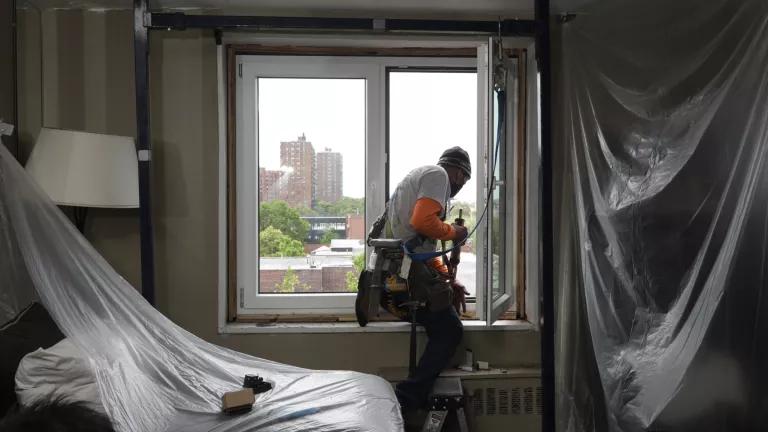A Better Way to Encourage Efficient New Homes
Building a more energy efficient home can employ many different approaches. The builder can use more insulation and better windows, they can install ductless heating and cooling systems, they can orient the house to collect sunshine through the windows in winter and shade them in summer, they can seal leaks in the walls and ceilings and assure healthy indoor air 24/7 by providing reliable mechanical ventilation with energy recovery, they can use cool roofs, and the list goes on...
Traditional building energy codes and efficiency incentives have focused on promoting one or several of these technologies in an inflexible package, requiring specified amounts of insulation in the floor, walls, and roofs, specified heating and cooling efficiency, specified air leakage…. This prescriptive approach succeeds at improving efficiency at low cost, but does not give credit for energy savings from comprehensive or holistic design strategies. Furthermore, the specific measures promoted within codes and incentive program change over time, causing uncertainty in the industry.
Builders therefore tend to resist it because it reduces their flexibility and is more expensive than it needs to be for any given energy efficiency target.
For example, perhaps one of the specified criteria is very expensive to meet for a particular house while another technology that might cost much less could save even more energy.
NRDC has been working with builders and building efficiency suppliers, as well as with nonprofit efficiency advocates, to introduce the combination of more ambitious energy goals and more flexible ways of meeting them into building energy codes and other market-based programs described next. The cornerstone of these methods is the HERS Index, a home energy inspection and rating method developed by RESNET, a nonprofit standard-setting organization that NRDC has supported since its inception. Markets in energy efficiency can only work if buyers and sellers have the information needed to evaluate energy efficiency in dollars. Long-term transformation of efficient construction practices relies on allowing stakeholders across the new construction industry to compete for overall home performance, not just incremental improvements in individual technologies.
The HERS Index is similar to a miles-per-gallon sticker on a car: it projects energy use compared to a baseline. The baseline score of 100 is based on a house that meets the 2006 energy code, while a score of 0 means zero energy use, on net.
More than 20 percent of new homes were rated in 2017, with an average score of 62, which is impressive considering that few entities provide incentives for such ratings. A score of 62 is some 15 percent better than the requirements of the most advanced model energy code in America. How much better could we do with financial incentives for the lowest scores?
We hope to find out soon.
The Consortium for Energy Efficiency (CEE)--an organization of North American utilities and other efficiency program administrators that supports their members’ work to advance energy efficiency by developing common specifications for efficiency-- adopted a specification for efficiency in new homes on January 16, 2018. This spec is based on the Energy Rating Index (ERI), a generic form of the HERS Index. The ERI provides a consistent signal to home builders about the level(s) of higher efficiency that utilities want. It also allows tangential market actors, such as lenders and appraisers, to compare homes’ overall energy performance against each other.
Manufacturers are more inclined to make higher efficiency products when they know in advance that utilities throughout the North American market will all be promoting the same level of efficiency. By providing a binational market signal, CEE members can cause manufacturers to offer products at higher levels of efficiency than they could justify otherwise. This dynamic applies to new homes, too: last year just 19 companies built 35 percent of all single family homes in America.
Housing accounts for one fifth of climate change-causing emissions and for some 4 percent of household expenditures (almost $2500 a year, or $75,000 over the life of a mortgage). The CEE specification offers participating utilities the choice of incentivizing one or several levels of efficiency. The mid-range level represents a reduction in energy use of about 40 percent compared to the energy use of a typical new home that meets state energy code. It could easily save the consumer $500 to $1000 in annual utility bills.
HERS ratings lead to competition between builders for who can build to the lowest score; however this competition is still restrained by the fact that increased energy efficiency often costs more, and the lending system does not yet recognize the value in determining whether a family qualifies for a mortgage. Utilities frequently address this barrier by offering the builder or buyer a cash incentive for efficiency that compensates for the cost increase. (This approach was also used extremely effectively in federal tax incentives for energy efficient home construction that were in effect from 2005 to 2012.)
By setting a specification that includes several very ambitious tiers of HERS/ERI scores, as well as more modest options that can work in areas where efficiency is a new idea, CEE is leading the way in harnessing market forces to work in coordination with energy codes to promote continual improvement in home energy efficiency.



